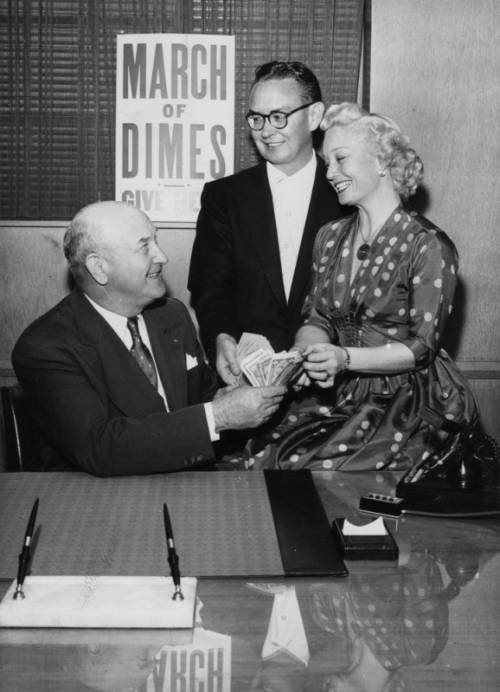Check out the Summer 2023 issue of Nostalgia Digest magazine, which includes my article about Shirley Temple’s life after her child star days.

Ina Ray Hutton on the sheet music of Moonglow circa 1934. Source: Pinterest
Ina Ray Hutton is remembered as a glamorous band leader and singer of the 1930s and 40s, sometimes overshadowing how she challenged barriers in the music industry. Born Odessa Cowan, she was a dancer on stage by 7 years old. In 1933, at the age of 17, music publisher and manager/agent Irving Mills offered her to lead an all-female band. He recalled to the San Bernardino Sun in 1956, “. . . I talked to Ina about the idea . . . and while it appealed to her, she was frightened. She couldn’t read music; she couldn’t play a musical instrument. All she could do was sing a little, dance a lot, wave the baton—and look beautiful. . .” Within time Hutton learned to read music, audition musicians and manage an orchestra.
During the 1930s, Ina Ray Hutton and Her Melodears successfully toured across the country and appeared in the movie Big Broadcast of 1936. Mills gave her an exciting opportunity, but it was a publicity stunt–a swing band fronted by an attractive young woman in fitted gowns who also sang vocals. Journal News in 1935 predicted, “The gals will have their own orchestras in profusion this Summer [sic] and the fad of the female jazzicists [sic] is due mostly to the rise of Ina Ray Hutton, whose skirted saxophone tooters have curled the air waves and populated dance floors and movie palaces on a rising scale for two years . . .” Others knew these were hardworking musicians. Daily Illini in 1936 wrote, “[Ina Ray Hutton’s] ensemble of talented girl musicians is rated as the best of its kind.” By 1939, Hutton was no longer with Mills and began a band with men. Weekly Gettysburgian was one example of the era’s prejudice towards women musicians commenting, “Ina Ray Hutton is finally going places with her new outfit of males . . . Girls should play—but not instruments.” Her vibrant signature became conducting while dancing.

Ina Ray Hutton on the April 15, 1940 issue of Down Beat magazine. Source: Pinterest
In the 1940s, Hutton transitioned into the big band era and proficiently led male musicians. She dyed her hair brunette for a time and opted for stage clothes that were still elegant, yet more professional. During this change to her image, her band reached more prominence. In December 1941 she became the first female bandleader featured on radio’s Spotlight Bands. Hutton later explained to the San Bernardino Sun her reason for a male band in the 1940s, “. . So many of my girls were getting married. . It took me two years to get the right boys. Then I had a really great band.” Although her orchestra recorded a few songs and were in the musical Ever Since Venus (1944), they were more active in live performances. For 9 years, they performed at USO functions, movie palaces and hotel ballrooms. This wasn’t a gimmick. She also told the paper, “When [the orchestra] broke up, the boys went with Stan Kenton, Tommy Dorsey, Woody Herman—to give you an idea of how great they were as musicians.” Hear 2 of their many spots on Victory Parade of Spotlight Bands in January 1943 and April 1944:
In 1950 she was the first female bandleader on TV. Hutton had an all-girl orchestra again seen each week in their own show on KTLA, performing old favorites and modern songs. San Bernardino Sun reported her initial reason for this venture was to be near home to care for her husband, trumpeter Randy Brooks, who was recovering from a cerebral hemorrhage. This way Hutton could still be active in music without touring. In fact, her success on TV led to local bookings such as county fairs, a festival for City Creek Highway in Running Springs and a benefit for Temple Israel. Her show remained popular during the entire decade.

Original caption: “January 29, 1955. Dance for Dimes March. Councilman Everett Burkhalter, left, buys block of dance tickets from Ina Ray Hutton and Jess F. High, chairman of March of Dimes Dance tonight at Devonshire Downs. Miss Hutton’s band will entertain. Tickets at door, $1 per donation. All proceeds will go to the March of Dimes.” Courtesy of Valley Times Collection/Los Angeles Public Library
There was a difference she’d observed with female and male musicians. While she stated to the San Bernardino Sun that she wasn’t against men musicians, she described them as “wistful dreamers with a strange concept for time and detail. They also believe in masculine superiority and generally speaking, they’re neurotic.” Instead she believed females were more dependable and explained, “The girl who wants to become [a musician] usually has a lot of discipline and will-power. . . It’s more than a job to her. It’s a profession, a way of life. . . . One reason girls work harder is because they’re constantly trying to prove that their musicianship is just as good as any man’s. And in many cases it’s better. They get the same salary scale as men and they’re twice as determined to show they’re worth it. . . I’ve never had any quarrels about solos or credits or place-positions with girls. . .”
After the 1960s, Hutton’s music career quietly closed and she died in 1984. Her physical appearance continues to be likened to pin-up artwork, however her legacy is beyond any idealized depiction. She took an opportunity that many predicted would be short-lived and turned it into an accomplished career for over 25 years presenting well-crafted music.
See Ina Ray Hutton and her All-Girl Orchestra
